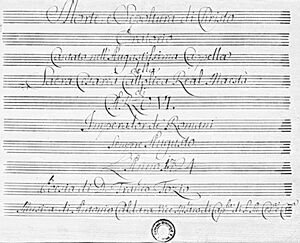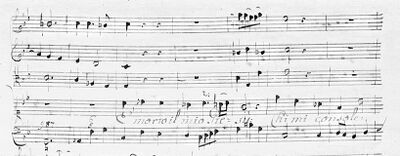Difference between revisions of "È morto il mio Gesù"
| (16 intermediate revisions by the same user not shown) | |||
| Line 57: | Line 57: | ||
| Audio sample? = <!-- Set to yes if an audio sample is needed, places page in [[Category:Song articles missing an audio sample]] --> | | Audio sample? = <!-- Set to yes if an audio sample is needed, places page in [[Category:Song articles missing an audio sample]] --> | ||
}} | }} | ||
'''"{{lang|it|È morto il mio Gesù}}"''' is an aria from the oratorio | '''"{{lang|it|È morto il mio Gesù}}"''' is an aria from the oratorio ''[[Morte e sepoltura di Christo]]'' (engl.: Christ's Death and Burial) by [[Antonio Caldara]]. The libretto was created by [[Francesco Fozio]]; the work was first performed in Vienna in 1724.<ref name="Wiki"/> | ||
The role of ''Maria di Giacobbe'' was first created by [[Giovanni Carestini]].<ref name="IMSLP"/><ref name="EClassical"/> | |||
==''"Maria di Giacobbe"''== | ==''"Maria di Giacobbe"''== | ||
In the medieval ''Legenda aurea'', Cleophas is directly identified with Alphaeus, the father of | In the medieval ''Legenda aurea'', Cleophas is directly identified with Alphaeus, the father of James the Younger (Mt 10:28 EU), so that his wife Mary is regarded as the mother of James the Younger, Simon Zelotes and Judas Thaddeus. This identification is also held today by some, mostly Catholic interpreters, who assume a sameness or alternation of names of one and the same person due to the similarity of the names, as it occurred more frequently with the Graecization of Jewish names (the assumption presumes a person with the seminitic name "Chalpai").''(Translated from German Wikipedia)''<ref name="WikiK"/> | ||
The disciple called "James" in the English King James Bible (and in most other translations) is called ''"Giacobbe"'' in Italian (''"Jakob"'' in German).<ref name="James"/> | |||
The aria ''"È morto il mio Gesù"'' appears on the following album: | The aria ''"È morto il mio Gesù"'' appears on the following album: | ||
| Line 110: | Line 114: | ||
{{Libretti | {{Libretti | ||
| country =Italy | | country =Italy | ||
| language-note = | | language-note =Modernized Italian | ||
| libretto-text =<poem>{{lang|it|Caro Giesù, qual ti rimiro, | | libretto-text =<poem>{{lang|it|'''Recitativo''' | ||
Caro Giesù, qual ti rimiro, | |||
ahi lassa! Lacero, esangue! | ahi lassa! Lacero, esangue! | ||
e voi, mie luci ingrate, | e voi, mie luci ingrate, | ||
| Line 123: | Line 128: | ||
già manca ogni conforto all’alma. | già manca ogni conforto all’alma. | ||
'''Aria''' | |||
È morto il mio Giesù: | È morto il mio Giesù: | ||
Chi me consolerà, | Chi me consolerà, | ||
| Line 134: | Line 140: | ||
| country =Italy | | country =Italy | ||
| language-note =Ancient Italian | | language-note =Ancient Italian | ||
| libretto-text =<poem>{{lang|it|Caro Giesù, qual ti rimiro, | | libretto-text =<poem>{{lang|it|'''Recitativo''' | ||
Caro Giesù, qual ti rimiro, | |||
ahi lassa! Lacero, esangue! | ahi lassa! Lacero, esangue! | ||
e voi, mie luci ingrate, | e voi, mie luci ingrate, | ||
| Line 146: | Line 153: | ||
già manca ogni conforto all’alma. | già manca ogni conforto all’alma. | ||
'''Aria''' | |||
È morto il mio Giesù: | È morto il mio Giesù: | ||
Chi me consolerà, | Chi me consolerà, | ||
| Line 155: | Line 163: | ||
Ahi! ahi quando rivedrò | Ahi! ahi quando rivedrò | ||
suo bel sereno.}}</poem><div class="footnotes"><poem> | suo bel sereno.}}</poem><div class="footnotes"><poem> | ||
<nowiki>*</nowiki>) "Vccidestimi" → "Uccidetemi" | <nowiki>*</nowiki>) "Vccidestimi" → "Uccidetemi"</poem></div>}}{{Libretti | ||
</poem | |||
{{Libretti | |||
| country =United Kingdom | | country =United Kingdom | ||
| language-note = | | language-note = | ||
| libretto-text =<poem></poem> | | libretto-text =<poem>'''Recitativo''' | ||
}}{{Libretti | Dear Jesus, as I behold thee, | ||
Alas! Lacerated, bloodless! | |||
And you, my ungrateful eyes, | |||
oppressed by the blind horror of death | |||
you see the divine light | |||
in the end, and you are not yet dark, | |||
and blind? | |||
Kill me, my anguish; | |||
It is only fair that this | |||
afflicted body should die | |||
which already cannot give any comfort to the soul. | |||
'''Aria''' | |||
My Jesus is dead: | |||
Who will comfort me? | |||
tell me, for pity's sake, | |||
you, stars, at least. | |||
I can no longer live, | |||
now that my sun is gone: | |||
Alas, when will I see again | |||
its beautiful solace. | |||
<ref name="FR"/></poem> | |||
}}<!--{{Libretti | |||
| country =Germany | | country =Germany | ||
| language-note = | | language-note = | ||
| libretto-text =<poem><ref name="FR"/></poem> | | libretto-text =<poem><ref name="FR"/></poem> | ||
}} | }}--> | ||
</div> | </div> | ||
{{Clear|left}} | {{Clear|left}} | ||
==Manuscripts and sheet music== | ==Manuscripts and sheet music== | ||
[[File:Incipit of | [[File:Incipit of E morto il mio Gesu.jpg|thumb|400px|alt=Incipit of "È morto il mio Gesù"|Incipit of "È morto il mio Gesù"]] | ||
<!-- incipit --> | |||
:Free Score at the IMSLP: | :Free Score at the IMSLP: | ||
:Copyist of Vienna | :Copyist of Vienna | ||
| Line 247: | Line 277: | ||
|quote=}} | |quote=}} | ||
</ref> | </ref> | ||
<ref name="James"> | |||
{{cite web | |||
|url=https://en.wikipedia.org/wiki/James,_brother_of_Jesus | |||
|archive-url=https://web.archive.org/web/20211015093501/https://en.wikipedia.org/wiki/James,_brother_of_Jesus | |||
|title=James, brother of Jesus | |||
|last= | |||
|first= | |||
|date= | |||
|website=Wikipedia | |||
|publisher= | |||
|access-date={{date|2021-10-14|DMY}} | |||
|archive-date={{date|2021-10-14|DMY}} | |||
|quote=}} | |||
</ref> | |||
<ref name="FR">English translation by Birikein & FR, 2021</ref> | |||
}} | }} | ||
[[Category:18th-century music]] | [[Category:18th-century music]] | ||
[[Category:sacred]]<!-- secular or sacred --> | [[Category:sacred]]<!-- secular or sacred --> | ||
Latest revision as of 23:15, 7 November 2021
| Morte e sepoltura di Christo | |
|---|---|
| by Antonio Caldara | |
 First page of Morte e sepultura di Christo, 1724[1] | |
| English | Christ's Death and Burial |
| Genre | Oratorio |
| Libretto | Francesco Fozio |
| Premiere | |
| Date | 23 March 1724 |
| Location | Vienna, Hoftheater |
"È morto il mio Gesù" is an aria from the oratorio Morte e sepoltura di Christo (engl.: Christ's Death and Burial) by Antonio Caldara. The libretto was created by Francesco Fozio; the work was first performed in Vienna in 1724.[2]
The role of Maria di Giacobbe was first created by Giovanni Carestini.[1][3]
"Maria di Giacobbe"
In the medieval Legenda aurea, Cleophas is directly identified with Alphaeus, the father of James the Younger (Mt 10:28 EU), so that his wife Mary is regarded as the mother of James the Younger, Simon Zelotes and Judas Thaddeus. This identification is also held today by some, mostly Catholic interpreters, who assume a sameness or alternation of names of one and the same person due to the similarity of the names, as it occurred more frequently with the Graecization of Jewish names (the assumption presumes a person with the seminitic name "Chalpai").(Translated from German Wikipedia)[4]
The disciple called "James" in the English King James Bible (and in most other translations) is called "Giacobbe" in Italian ("Jakob" in German).[5]
The aria "È morto il mio Gesù" appears on the following album:
| Year | Album | Ensemble |
|---|---|---|
| 2020 | La Vanità del Mondo (Album) | Artaserse |
It is part of the following concert program:
| Year | Concert program | Ensemble |
|---|---|---|
| 2020 | È morto il mio Gesù (Concert program) | Artaserse |
Libretto
from Morte e sepoltura di Christo
Antonio Caldara (music), Francesco Fozio (words)
Modernized Italian | |
Recitativo | |
Ancient Italian | |
Recitativo *) "Vccidestimi" → "Uccidetemi" | |
Recitativo | |
Manuscripts and sheet music
- Free Score at the IMSLP:
- Copyist of Vienna
- Manuscript, n.d.(ca.1724).
- Copyright: Public Domain
- Österreichische Nationalbibliothek, Vienna (A-Wn): Mus.Hs.17120
- Caldara, Antonio (1724). "Morte e sepoltura di Cristo". IMSLP. Archived from the original on 14 October 2021. Retrieved 14 October 2021.
References
- ↑ 1.0 1.1 Caldara, Antonio (1724). "Morte e sepoltura di Cristo". IMSLP. Archived from the original on 14 October 2021. Retrieved 14 October 2021.
- ↑ "Giuseppe Porsile". Wikipedia. Archived from the original on 14 October 2021. Retrieved 14 October 2021.
- ↑ "CD Booklet: Antonio Caldara, Morte e sepoltura di Christo, Fabio Biondi, Stavanger Symphony Orchestra, Schiavo, Frigato, Belli, Giustiniani, Guagliardo" (PDF). Wikipedia. 2015. Archived from the original (PDF) on 14 October 2021. Retrieved 14 October 2021.
- ↑ "Maria Kleophae". Wikipedia. Archived from the original on 14 October 2021. Retrieved 14 October 2021.
- ↑ "James, brother of Jesus". Wikipedia. Archived from the original on 14 October 2021. Retrieved 14 October 2021.
- ↑ English translation by Birikein & FR, 2021
